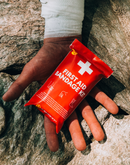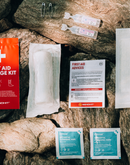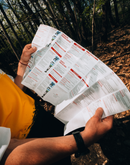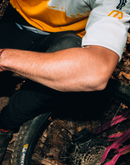ULTRALIGHT FIRST AID BANDAGE KIT
FIRST AID BANDAGE KIT
THE MINIMUM RATHER THAN NOTHING
We know that mountain bikers are tough people and that they are not interested in carrying a large first aid kit with them on every ride, nor are they interested in the classic lightweight Outdoor first aid kit that contains plasters of all sizes.
That's why, at Sendhit, we've thought about the minimum you should take with you and the injuries it could treat.
Unless you have bulky medical equipment (Boston splint, blanket, combat tourniquet, etc.), many common mountain biking injuries, such as fractures, dislocations, concussions, require proper first aid before being treated by a rescuer or medical personnel.
So we decided to focus on common injuries that can nethertheless be serious and distressing, such as significant bleeding or a large wound with raw flesh.
In these situations, having a large first-aid bandage can be very useful in limiting the damage so that you can return home or wait for help in the best possible conditions.
NO MORE EXCUSE
We're sorry to say that you'll have a hard time finding excuses not to have one with you:
- Weighing in at just 45 grams (0,099 lbs), this kit is ultra-light, even for the most weight weenies enthusiasts.
- Its ultra-compact format (125x70x40 mm / 4.921x2.755x1.574 inches) means it can fit into a backpack, a hip bag or even a frame box.
- The zip bag is mud and water splash resistant.
- And with its low price, it's within everyone's reach, not forgetting that in critical situations, money is never the issue.
WHAT'S INSIDE THE KIT ?
The single-use kit includes everything you need to clean, disinfect, close and bandage your wound:
- 1 First aid bandage including a 10x12 cm (3.937x4.724 inches) compress and 2.7 m (8.858 feet) of gas tape.
- 5 wound closure stripes 5x100 mm.
- 2 physiolical serum (5 ml).
- 2 antiseptic wipes.
- 2 safety pins.
- 1 First Aid instructions manual in 5 languages : English, French, German, Spanish and Italian.
A GUIDE TO FIRST AID
Dealing with injuries isn't just about having medical equipment with you; an emergency situation requires quick and consistent decisions. This manual provides key information and the first steps to take in the event of an accident:
How to react if you or a friend is injuerd on the trail ?
Symptoms/Treatment:
- Concussion
- Spinal injury
- Heart attack
- Shock
- Internal bleeding
- External bleeding
- Fracture / Dislocation
- Wound / graze / cut
How to:
- How to practice a CPR
- How to practice a MILS
- How to put someone in recovery position
- How to control bleeding
- How to dress a wound
- How to apply wound closure strips
- How to do a splint
As any attempt to provide first aid is better than no attempt at all, we provide some basic pointers that can help facing a injury on the trail. By no means does reading these pointers substitute for formal First Aid training and we strongly recommend everyone to take a course.










